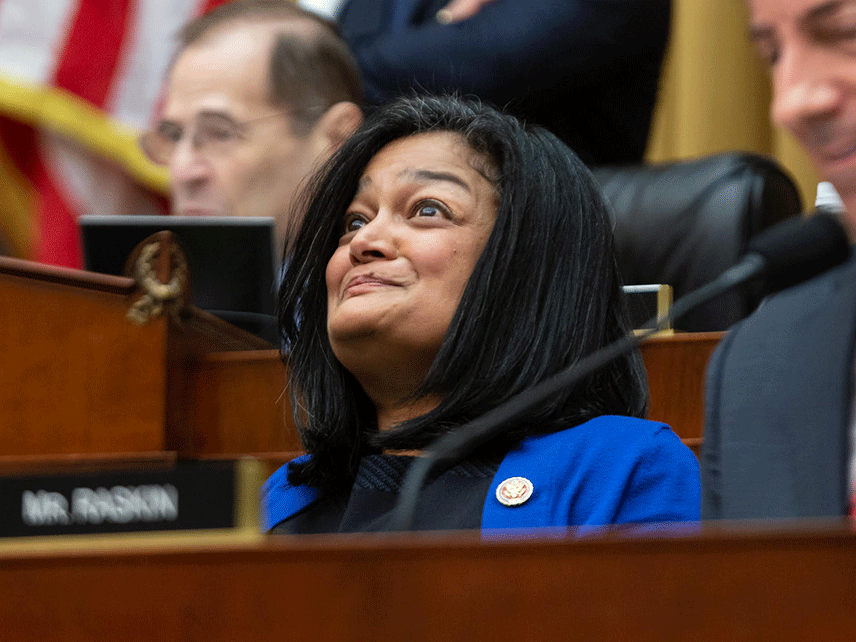More Than 100 House Democrats Endorse Medicare for All Plan That Would Eliminate Private Health Insurance in Just Two Years
A new single-payer plan would be even more disruptive and expensive than Bernie Sanders' proposal.

Over the last two years, Americans have become increasingly open to the idea of Medicare for All, partly as a result of single-payer proposals like the one put forth by Sen. Bernie Sanders (I-Vt.).
This, in turn, has led much of the Democratic Party's 2020 field to embrace the label. Yet Medicare for All's rise has coincided with a dilution of the phrase's meaning. To some, it still means strict single-payer, with all of the costs and disruption that entails; to others, it merely means some expansion of government involvement in health care, perhaps using today's Medicare program for seniors as a foundation.
The fuzziness of the label's meaning has clearly helped aid its rise: Polls consistently show that Medicare for All is popular only until people are told what it would entail in its single-payer form—higher taxes and a massive increase in government spending, the end of Medicare as we know it today, and the swift elimination of current private health insurance, which covers nearly 180 million Americans. Even simply calling the idea of a government-run health plan "single-payer" significantly reduces public support.
This reality of public opinion explains, for example, why Sen. Kamala Harris (D-Ca.) softened her position on single-payer after saying she would eliminate private health insurance, and why Sen. Amy Klobuchar (D-Minn.) has taken to describing it as "aspirational." Medicare for All has found success as an ambiguous slogan, but not as a specific policy, because the specific policy it is most associated with—government-run single-payer health insurance—is broadly unpopular.
Today, a group of more than 100 House Democrats, led by Rep. Pramila Jayapal (D-Wash.), are introducing new Medicare for All legislation. The intent of the release, supporters of the plan say, is to clarify what, exactly, Medicare for All refers to. And what it apparently refers to is a plan that includes, and expands upon, all of the most disruptive and least popular elements of single-payer.
Among other things, the Jayapal bill would eliminate existing private health coverage arrangements in just two years—even faster than the four-year timeline called for in the Sanders plan. Some private supplementary coverage might exist after the transition, but the market for private coverage as we know it would end. Indeed, Jayapal has foregrounded the plan's disruption of existing coverage: "We mean a complete transformation of our health care system and we mean a system where there are no private insurance companies that provide these core benefits," she told reporters yesterday.
The transformation she describes would extend to Medicare itself. Although the plan is labeled Medicare for all, it would not simply extend Medicare in its current form to all Americans. Instead, as The New York Times reports, it would "drastically reshape Medicare itself." Medicare, which faces a trust-fund shortfall in the next decade and is among the biggest drivers of the long-term federal debt, is certainly in need of significant reforms, but polling shows that Medicare for All becomes unpopular if it is understood as a threat to Medicare as it exists now.
The most significant way that the new plan would change Medicare is by overhauling how it pays hospitals, moving from individual service-based payments to global budgeting, which caps total spending and then allocates amongst providers accordingly. These reforms would be certain to spark intense opposition from the health care industry, which would argue that a federally-imposed cap on payments would lead to longer waits to see doctors, delays in treatment, and other forms of rationing. In a recent poll by the Kaiser Family Foundation, the single most effective criticism of Medicare for All was that it would lead to delays in medical tests and treatments. Although that poll found that 56 percent of respondents supported a plan in which all Americans get insurance from the government (essentially single-payer), support dropped to 26 percent when treatment delays were raised as a consequence.
Not only is Jayapal's plan more disruptive than predecessors, it is probably more expensive, providing for additional long-term care services not part of today's Medicare system or the Sanders Medicare for All bill.
Like previous single-payer plans, however, Jayapal's bill does not explain how the new system would be financed. Multiple estimates have put the federal price tag for the Sanders plan at around $32 trillion over a decade, even under generous assumptions about the ability and willingness of the health care industry to absorb significant payment reductions.
Jayapal has positioned her bill as a corrective to anyone who might think that Medicare for All means anything other than a strict single-payer plan. "I think this 'Medicare for All' bill really makes it clear what we mean by 'Medicare for All,'" she said yesterday in advance of the plan's announcement. In that sense, at least, the new bill is a success. What she and the other Democrats who have signed onto the legislation have clarified is that they support a plan that is even more disruptive, more expensive, and probably less popular than prior single-payer plans.
Show Comments (216)